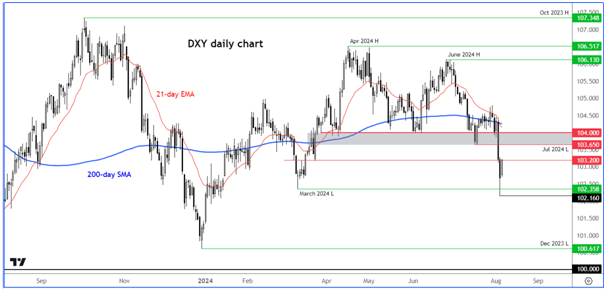While US indexes, Nikkei futures, the USD/JPY and commodity dollars – some of the assets that have come under intense pressure – all bounced off their lows on Monday, we haven’t seen much follow-through so far in Tuesday’s session.
This suggests that we are not out of the woods yet. But things could calm down as we head deeper into the week. A quieter US economic calendar means there won’t be many fresh recession signals to unnerve traders while soothing comments from Fed officials could also help alleviate the pressure on markets.
Dollar Index Could Resume Lower as it Tests Key Resistance
The EUR/USD was actually trading lower at the time of writing on Tuesday, unable to build onto its two-day rally, hurt by a surprise 0.3% m/m drop in Eurozone retail sales. This has helped to lift the Dollar Index off its multi-month lows.
The US Dollar Index (DXY) was testing potential resistance around 103.20 at the time of writing, while a more significant resistance is seen in the range between 103.65 to 104.00. Following the recent bearish price action, be on the lookout for a fresh drop in the DXY around these levels.

Source: TradingView.com
Indeed, the broader US dollar direction should turn more negative once the equity markets show signs of stabilization in light of the sharp repricing of US interest rates. The unwind of carry trades was the dominant theme at the start of this week and we saw some big moves in the likes of the Japanese yen and Swiss franc, while equity indexes and US futures slumped before staging a minor bounce following the stronger ISM services PMI data.
But once the dust settles in the equity markets, we could see other currencies start to perform better against the dollar too. So far, we have only seen the euro show any signs of strength apart from those with lower interest rates – JPY, CHF, and CNH.
What has Been Happening in FX Markets Recently?
It’s been a rough ride for global risk assets lately, and the turbulence shows little signs of easing at the start of this week. Investors have been gripped by fears that the Federal Reserve has waited too long to pivot on its policy, especially in light of Friday’s disappointing US jobs data and a slew of other weak economic indicators pointing toward a looming recession. Monday’s publication of a stronger ISM services PMI helped to modestly ease concerns somewhat, causing yields to bounce back.
It appears as though Friday’s soft jobs report was a game-changer for US rates markets. Short-term US yields took a nosedive as the market consensus shifted dramatically, now expecting the Fed to slash rates significantly this year. We're talking about a massive shift: the market is now pricing in around 120 basis points of Fed rate cuts before year-end, all driven by recession fears. No more hoping for a smooth, orderly adjustment in Fed policy. Investors are now bracing for a 50-basis point cut in September, double the 25 basis points they were anticipating before.
Falling bond yields have flipped the script on low-yielding currencies. After a tough first half of the year, these currencies are now on the rise. With the Fed and other major central banks expected to lower interest rates, the US dollar and other high-beta currencies have given way in favor of the Japanese yen, Swiss franc, and Chinese renminbi. In particular, the USD/JPY has been getting a hammering from last week’s hawkish BOJ rate decision, adding to its newfound strength.
What to Expect Next for US Dollar?
Well, I would be very surprised if the Fed refuses to offer some soothing words in light of the big moves we have seen. There are not many Fed speakers on tap this week, but Chicago Fed President Austan Goolsbee yesterday said if the economy were to deteriorate, the Fed would “fix it”. Fed officials will have to choose their words carefully, as more evidence of an economic slowdown could emerge in the coming weeks.
The sharp correction in equities has put high beta currencies under pressure, preventing them from benefiting from significantly lower US rates. It has been a tough environment out there, and it seems like these currencies just can’t catch a break – even though they managed to bounce nicely off their lows yesterday, there wasn’t much in the way of follow-through today.
However, once the asset markets stabilize, we should see a different story unfold. The dollar is likely to weaken across the board as its yield advantage has been substantially reduced. So, while high beta currencies are struggling, there's potential for a rebound once things settle down.
So, What is a Carry Trade Anyway?
In case you were wondering, carry trade is a strategy where traders borrow money at low interest rates and invest it in higher-yielding assets. It’s a popular tactic in forex trading, where investors take advantage of low interest rates and weaker currencies in one country to reinvest in another country with higher returns.
Japan has been a favorite for carry trade, thanks to the Bank of Japan’s ultra-loose policy that’s been in place for many years, coupled with a weak yen. This has made the yen an attractive option for global investors looking to maximize their returns through carry trades.
***
Disclaimer: This article is written for informational purposes only; it does not constitute a solicitation, offer, advice, counsel or recommendation to invest as such it is not intended to incentivize the purchase of assets in any way. I would like to remind you that any type of asset, is evaluated from multiple perspectives and is highly risky and therefore, any investment decision and the associated risk remains with the investor.
